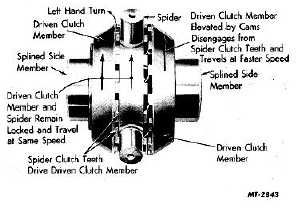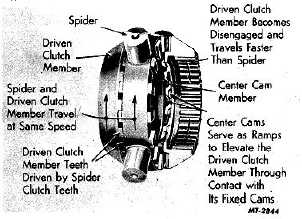|
| |
TRUCK SERVICE MANUAL
TM 5-4210-230-14&P-1
This
engagement
and
disengagement
or
indexing operation continues throughout the turn with a
rapidity that is in direct relation to the speed of the
overrunning wheel.
As the vehicle completes the turn and is again
driven in a straight forward direction, differential action
no longer being required, both driven clutch members
become fully engaged with the clutch teeth of the spider;
then the operation, as described in "Straight Forward
Driving, " is resumed.
Forward Right-Hand Turn Braking Condition
In this situation, the vehicle is moving forward,
but the direction of torque of the ring gear is reversed,
because the vehicle is being slowed down by braking
action. This reversal of torque is produced by the action
of road traction driving the wheels against the torque of
the engine. In this condition, when a righthand turn is
negotiated, the left-hand (outside) wheels rotate at ring
gear speed, since the left-hand driven clutch member
remains fully engaged while the right-hand (inside)
wheels rotate slower than ring gear speed.
The symmetrical design of the differential
makes it possible to function in the manner described
above, which is, in effect, directly opposite to that
described as "RightHand Turn--Forward Direction."
It should be noted that if a turn is negotiated in
such a manner that power is first applied and then
braking action is encountered before the turn is
completed, the differential is designed to function
without interruption and will automatically take care of
such reversal of torque.
Fig. 40 Left-Hand Turn--Forward Direction
Left-Hand Turn Forward Direction
In making a left-hand turn with the vehicle driven in a
forward direction, the left-hand
wheel is on the inside of the turn and the power is
applied to it so that it must rotate at ring gear speed.
The right-hand wheel travels through the greater arc,
being on the outside of the turn. Its driven clutch
member becomes disengaged from the spider clutch
teeth, permitting it to be rotated by ground traction faster
than the ring gear, Figs. 40 and 41.
The operation of the driven clutch member on
the right side of the assembly in the foregoing instance
is illustrated above.
Fig. 41 Forward Left-Hand Turn (Cross Sectional View)
Fig. 42 Right-Hand Turn--Rearward Direction
Rightand Left-Hand Turns Rearward Direction
The operation of the NoSPIN differential when required
to make turns while traveling in a rearward direction is
identical to that when making turns in a forward
direction. When moving rearward in a turn under power,
CTS-2095S - Chapter II - Page 5
PRINTED IN UNITED STATES OF AMERICA
|



